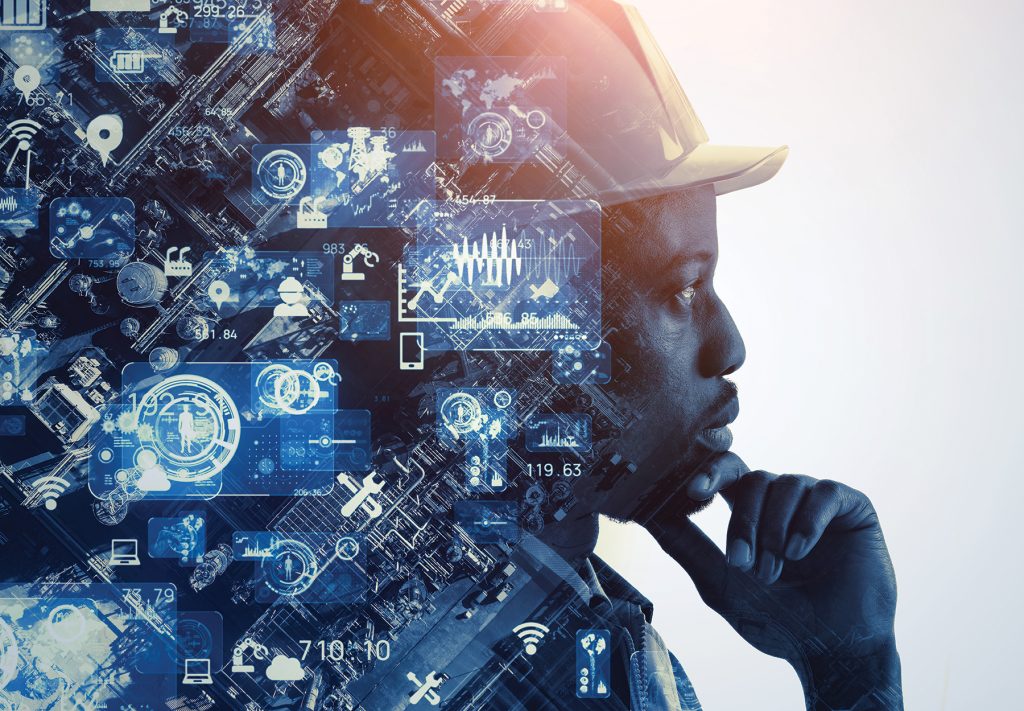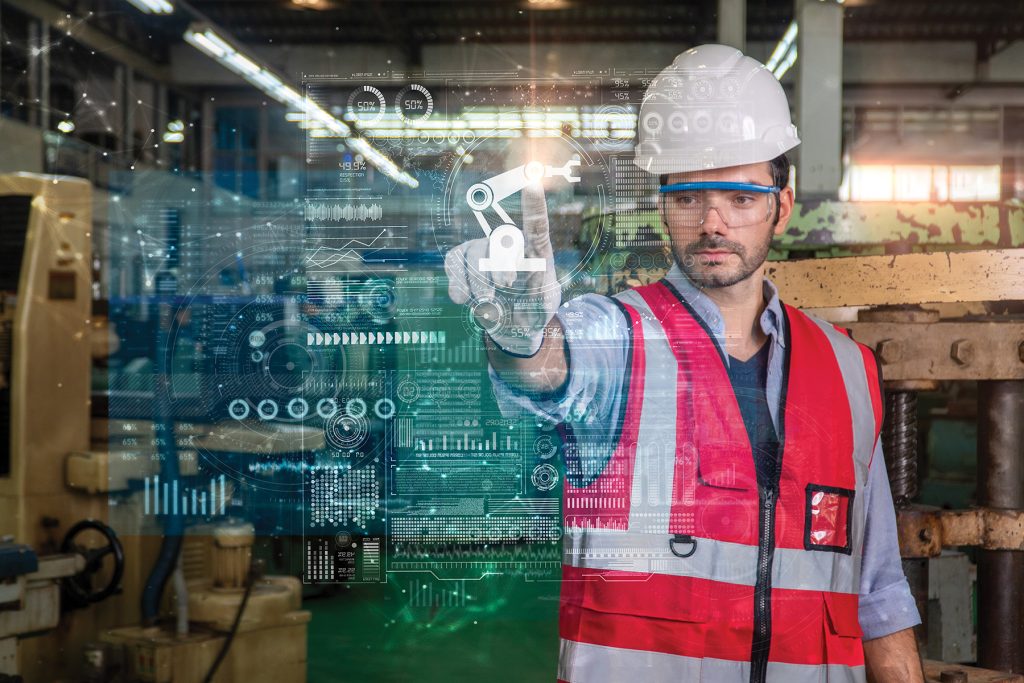
The future of maintenance
It’s been a year where various regulations and restrictions are in place since a global pandemic took hold in early 2020. Many processes around the world have changed to adapt, including maintenance practices. In turn, now is a good time to look at how maintenance has evolved and where it’s heading.
January 20, 2022 | By Maryam Farag
 Photo: (c) metamorworks / Adobe Stock.
Photo: (c) metamorworks / Adobe Stock. 
Photo: Pugun & Photo Studio / Adobe Stock
There is no doubt that the future of maintenance will include digitization and automation. The expanded deployment of digital technologies across manufacturing plants, facilities, utilities, and other organizations is set to reduce labourious tasks, optimize maintenance schedules, increase preparedness and productivity, create safer environments for workers and improve the bottom lines of industrial organizations.
MRO enlisted a select group of maintenance experts – whose expertise includes asset management, maintenance consulting and training, supply chain management, and CMMS software – to help us build a snapshot of the future of the maintenance industry.
Asset Management
First, we spoke to Leonard G Middleton, Consultant at Asset Management Solutions, who believe that the one consistency we can expect is change.
“The rate of change will continue to accelerate, and organizations will need to be resilient, agile, and learning continuously, if they are to successfully ride the wave of these changes.
“With the increased automation and digitization, our capability to measure assets, processes and even people performing tasks continues to accelerate. However, our ability to assimilate this tsunami of data remains limited. Improved tools will be required to convert this often-incoherent stream of data into intelligent relevant information to make timely and informed actionable decisions.
“Recent circumstances, such as the global pandemic and global warming, demonstrated linkages (global supply chain disruptions, severe weather events) that many may not have realized existed, and now need to address those opportunities and constraints provided by the new normal, and be flexible and resilient for future disruptions.
“There remains a key source of competitive advantage for organizations: people. Capable motivated people that are flexible, embrace change and the learning that goes with it, will enable intelligent leadership to have the performance of their organization to exceed that of comparable competitors.”
Also speaking about asset management was Suzane Greeman, Principal Asset Management Advisor at Greeman Asset Management Solutions Inc.
“Asset dependent firms are beginning to embrace the growing complexity and uncertainty in their operating contexts. As the operating contexts continue to shape the role of the organization’s asset management system, it is clear that it is a fundamental element of the business model of asset dependent firms.
“A key role of the asset management system is to create trade-offs among the various capitals that the firm owns, and among its combination of assets, strategic direction of the business model, risks and opportunities in the external environment, and stakeholder value.
“Some external drivers that can be anticipated as the external context triggering changes in asset management systems include increased: external stakeholder activism driving, oversight from external agencies and executives, requirements to implement strategic asset management plans (SAMPs) and execute against the plans, use of asset management strategies and SAMPs to demonstrate long term risk assurance by external partners. As well as the use of SAMPs to demonstrate the organization has the capability to perform appropriate trade-offs and allocate funding by external financial partners including financial institutions and investors.
“Asset-intensive companies have been doing some form of asset management for a long time. However, the need to create formal asset management systems to lend structure and to assure stakeholders that risks are being managed, is not going away, and is simply taking its place as a permanent fixture in the operating context.
“While asset owning companies do not always overtly include their asset management systems as part of their business models currently, responding to changing operating context will require a tight partnership between the two. A partnership that will position asset management systems as key
business systems.”

Photo: (c) metamorworks / Adobe Stock.
Sustainability
Next, we spoke with Mariete F Pacheco, Managing Director at FRW Services Inc., who sees a continuation of sustainability within MRO, that has evolved a great deal over the years.
“Initially the strategy was implemented to win government contracts and tenders or as a method to save money.
“Acceptance of more sustainable products and practices has accelerated due to the greater emphasis on environmental and climate change concerns. The call for sustainability has gone beyond government requirements and has become a greater demand from consumers looking for corporate responsibility, and from business customers who are creating a sustainable supply chain across their supplier base.
“Sustainability is becoming more than a competitive advantage for organizations looking to differentiate themselves in the marketplace, it will soon be the norm and table stakes in some industries as governments roll out climate change mandates, looking to create circular economies.
“Sustainability also dovetails in the recent resurgence in re-shoring of manufacturing and buy local messages some communities are encouraging. There are limited regulations generally outside of North America that certify or warrant products as sustainable or better for the environment. Combine this with the ongoing uncertainty of the global supply chain, organizations are sourcing these sustainable products and many operationally critical products domestically to mitigate risks associated with raw material shortages, shipment delays or sky-rocking price increases.
“For some organizations, the sustainable products were used merely as a stop-gap alternative during the recent supply chain challenges, but as short-term challenges extended into longer-term issues, organizations have come to embrace these alternatives as commonplace due to their stability in availability and consistent performance.”
Maintenance Management
MRO also spoke to James Reyes-Picknell, Principal Consultant at Conscious Asset, who mentions that the management of maintenance is becoming far more challenging and no longer a role that can be fulfilled by competent technicians.
“Maintenance and its management have been headed south for a while. Short-sighted management decisions have long been setting the stage for more asset unreliability. Then came a pandemic that exacerbated some problems while hiding others.
“People skills, combined with the ability to think and then act strategically are becoming far more critical. Complexity is growing in parallel with our loss of ability to deal with it easily.
“COVID-19 changed how people work, especially where work is done on computers or in offices. However, maintenance isn’t an office job. Machines continued to operate and break, and maintenance never stopped. For technicians in the field, there were changes to shift and teaming arrangements, elimination of shift overlaps, reduction in contractor use, elimination of training, and outside consulting services and in some cases, a sustained increase in overtime.
“Implementation or upgrading of CMMS continues. Digitization initiatives continued to progress with growing interest in AI, machine learning and leveraging “big data.” Systems are becoming more feature rich, more integrated, and more complex. Most users of these systems still don’t measure their own results – an indication that the very systems intended to help in measuring, are missing the mark.
“What’s occurring in the workforce is a shift from dependency on others, to greater dependence on our own workforces, but with less training and minimal preparation. Some changes worked well (reduced contracting to supplement labour shortages), but others have not (reduced contracting when specialized services were needed).
“Training was reduced and even shut down in many companies. The need for outside help and consultants is likely to jump as companies realize they can’t keep up as post-COVID-19 demand surges.
“We are also nearing the end of the baby boomer retirements. A lot were retiring, and a lot of experience was being lost before the pandemic, and now COVID-19 has accelerated that trend. The window of opportunity to transfer knowledge to the less experienced workers is shrinking.
“The reduced demand for products lowered production pressures. Plants ran at lower outputs, lower stress levels, ran equipment with lighter loads, and suffered fewer failures. They seemed to run more reliably. Repairs are waiting longer and taking longer because of continuing supply chain problems.
“The move to digitization won’t correct all problems, at least not quickly enough. Machine learning and AI have their limitations. They are still not mature technologies. Expectations of technology still exceed capabilities. Corporate unwillingness to share data also leads to slower development of AI. Plenty is being learned as the early adopters make their attempts. Many of those first efforts at digitization are failing to achieve desired results, not total failures, but are largely disappointing.
“Newer and younger tech savvy managers expect that technology can “save the day,” but are being disappointed regularly. Realizing that they must learn people skills and develop a greater understanding of processes to achieve their companies’ goals.
“Today, and for the next few years, we see management going through a modern-day era of enlightenment. Technology development will continue, and capabilities will improve, but not fast enough. Managers can’t depend on technology as much as they would like. Many of the lessons learned from past mistakes are lost already, or in danger of being lost for want of methods and the corporate willingness to capture it. Smart people will learn quickly, but not until the mistakes are repeated.
“We see short term pain, gradual enlightenment in parallel with some good technology development, informed by those who understand the processes. That combination can truly help solve problems. Emphasis will shift from technology and back to people and processes as this awakening occurs. Gradually, perhaps within a generation, we’ll all move from a maturity level described as “learning” into varying levels of “competence.” MRO
_______________
Maryam Farag is the Associate Editor of Machinery and Equipment MRO magazine, Food and Beverage magazine, and Plant Magazine, Annex Business Media. Reach her at mfarag@annexbusinessmedia.com
